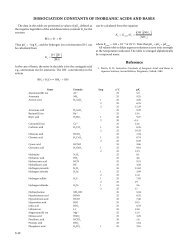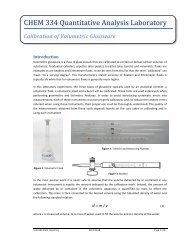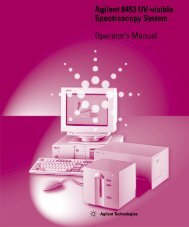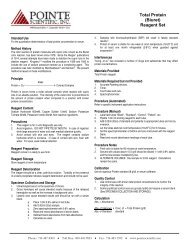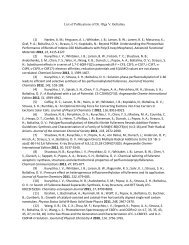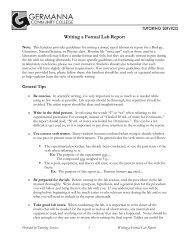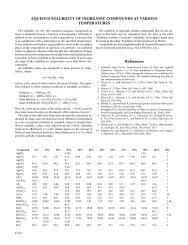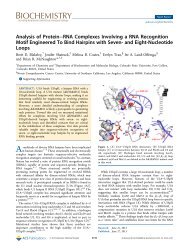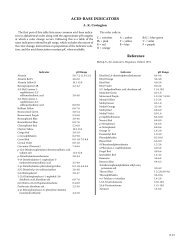1 Notes for Rotational-Vibrational Spectroscopy of 1HCl and 2HCl
1 Notes for Rotational-Vibrational Spectroscopy of 1HCl and 2HCl
1 Notes for Rotational-Vibrational Spectroscopy of 1HCl and 2HCl
Create successful ePaper yourself
Turn your PDF publications into a flip-book with our unique Google optimized e-Paper software.
Colorado State University<br />
CHEM 475<br />
Physical Chemistry Laboratory - 1<br />
<strong>Notes</strong> <strong>for</strong><br />
<strong>Rotational</strong>-<strong>Vibrational</strong> <strong>Spectroscopy</strong><br />
<strong>of</strong> <strong>1HCl</strong> <strong>and</strong> <strong>2HCl</strong><br />
The following is a set <strong>of</strong> short notes to outline the experiment in question <strong>and</strong> to provide helpful<br />
guidance to those executing the experiment.<br />
A. Heteronuclear atomic molecules provide excellent "test beds" <strong>for</strong> pro<strong>of</strong>ing models <strong>of</strong> the<br />
mechanics <strong>of</strong> atoms in molecules <strong>and</strong> their interaction with electromagnetic radiation.<br />
B. In another experiment in this laboratory, the absorption spectra <strong>of</strong> diatomic molecules<br />
was analyzed <strong>and</strong> predicted by use <strong>of</strong> the "harmonic oscillator" that models the<br />
interatomic distance between two atoms - behavior that gives rise to a varying molecular<br />
electric dipole that ultimately gives rise to an absorption, typically in the IR region.<br />
C. The harmonic oscillator can be improved upon by inclusion <strong>of</strong> the "rigid rotor" model that<br />
together will predict more detailed spectroscopic features.<br />
D. The gas cell used in this experiment is constructed with IR transparent ends (made from<br />
disks <strong>of</strong> NaCl, which is transparent to IR radiation) <strong>and</strong> is several centimeters long to<br />
provide sufficient optical density (absorbance) from the low-density gas. It must be<br />
stored in a desiccator when not in use to prevent "fogging" <strong>of</strong> the water-sensitive NaCl<br />
end plates. It must also be cleaned (flushed out) by gently (!) flowing nitrogen gas<br />
through it while it is in the hood. Collect a background spectrum (use "absorbance"<br />
mode not "percent transmittance") using the nitrogen-cleaned cell.<br />
E. Collect a high-quality IR spectrum <strong>of</strong> 1 HCl gas obtained from a "lecture bottle" (use<br />
"absorbance" mode not "percent transmittance"). Convert the spectrum file to ASCII<br />
<strong>for</strong>mat, transfer it to a suitable computer <strong>and</strong> analyze it with Igor Pro. Repeat this<br />
process until a suitable spectrum is obtained.<br />
F. In order to collect a corresponding spectrum <strong>of</strong> 2 HCl this isotopically substituted<br />
molecule must be prepared in the laboratory. A convenient procedure (with significant<br />
modifications!) <strong>for</strong> this purpose can be found in the textbook "Experiments in Physical<br />
Chemistry" authored by Shoemaker <strong>and</strong> Garl<strong>and</strong>. Flowing <strong>2HCl</strong> gas through it rather<br />
than the vacuum based procedure described in the textbook fills the two-valve cell used<br />
in this laboratory.<br />
G. Estimate the volume <strong>of</strong> the cell filling apparatus (to the ±20% level - do not<br />
overestimate) from the round-bottom generating flask to <strong>and</strong> including the cell itself<br />
(apparatus "down wind" from the cell is inconsequential). Use a convenient volume<br />
CHEM 475 - <strong>Rotational</strong>-<strong>Vibrational</strong> <strong>Spectroscopy</strong> 2014.10.07 Page 1 <strong>of</strong> 2
etween two <strong>and</strong> three times this estimate to ensure that a sufficient quantity <strong>of</strong> 2 HCl is<br />
generated to flush the cell adequately.<br />
H. Calculate the amount <strong>of</strong> benzoyl chloride <strong>and</strong> deuterated water needed to generate the<br />
needed amount <strong>of</strong> 2 HCl.<br />
I. Collect a high-quality IR spectrum <strong>of</strong> 2 HCl gas obtained (use "absorbance" mode not<br />
"percent transmittance"). Convert the spectrum file to ASCII <strong>for</strong>mat, transfer it to a<br />
suitable computer <strong>and</strong> analyze it with Igor Pro. Repeat this process until a suitable<br />
spectrum is obtained.<br />
J. Analyze both spectra using Igor roughly according to the Shoemaker <strong>and</strong> Garl<strong>and</strong><br />
procedure. Since the procedure was written prior to the widespread availability <strong>of</strong> high<br />
per<strong>for</strong>mance computers <strong>and</strong> s<strong>of</strong>tware it used certain outdated conventions. For example,<br />
identify the absorption maxima wavelengths <strong>and</strong> plot them (rather than the nearestneighbor<br />
wavelength differences). Fit these spectra, separately to both second <strong>and</strong> third<br />
order polynomials to extract the experimental values <strong>of</strong> parameters to use in the model.<br />
Per<strong>for</strong>m a suitable F-Test on the extracted values to determine if the third order<br />
polynomial fit is statistically more significant than the second order one. Complete the<br />
analysis as described in the procedure.<br />
CHEM 475 - <strong>Rotational</strong>-<strong>Vibrational</strong> <strong>Spectroscopy</strong> 2014.10.07 Page 2 <strong>of</strong> 2




